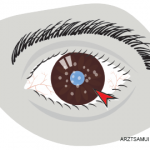 Within seven years of diagnosis, 13–24% of patients with juvenile idiopathic arthritis (JIA) will develop JIA-associated uveitis, a condition that may be effectively treated with adalimumab. Adalimumab was approved in Europe for the treatment of JIA-associated uveitis based on the results of the SYCAMORE trial. This randomized, placebo-controlled trial took place in 17 centers in the U.K. and showed clear therapeutic benefit of adalimumab for the treatment of JIA-associated uveitis. One center reported longer term outcomes in patients enrolled in the SYCAMORE trial, including visual acuity, safety and disease activity.
Within seven years of diagnosis, 13–24% of patients with juvenile idiopathic arthritis (JIA) will develop JIA-associated uveitis, a condition that may be effectively treated with adalimumab. Adalimumab was approved in Europe for the treatment of JIA-associated uveitis based on the results of the SYCAMORE trial. This randomized, placebo-controlled trial took place in 17 centers in the U.K. and showed clear therapeutic benefit of adalimumab for the treatment of JIA-associated uveitis. One center reported longer term outcomes in patients enrolled in the SYCAMORE trial, including visual acuity, safety and disease activity.
The Bristol Center contributed 31% of the total SYCAMORE cohort. Investigators in Bristol report that, although patients with JIA-associated uveitis tolerated treatment with adalimumab and experienced excellent visual acuity outcomes, drug-induced remission of JIA-associated uveitis did not persist once the drug was stopped after one to two years of treatment.
Sarah Horton, MD, honorary senior research associate of the Bristol Eye Hospital, U.K., and colleagues published the five-year, follow-up study of the Bristol participants of the SYCAMORE trial June 12 in the American Journal of Ophthalmology. The results of the retrospective interventional case series from the single trial center are consistent with a long-term role for adalimumab in the treatment of refractory JIA-associated uveitis.1
Investigators in Bristol randomized 28 patients in the SYCAMORE trial to receive adalimumab and methotrexate (n=19) or placebo and methotrexate (n=9). Twelve patients in the adalimumab arm and one patient in the placebo arm completed the trial. The SYCAMORE trial protocol included withdrawal of adalimumab—but not methotrexate—for all participants. The mean age at the final SYCAMORE visit was 10.25 years (standard deviation of 4.49), and 72% of the children were female.
The follow-up period began after adalimumab was stopped and included 81.62 total patient years, during which 26 of the 28 patients experienced a flare of their JIA-associated uveitis. During that time, 23 patients opted for adalimumab treatment for their active JIA-associated uveitis. Twenty-seven of the 28 Bristol participants demonstrated no unexplained or sustained reduction. Four participants developed a cataract during the extended study period, and one participant experienced a reduction in vision due to the cataract. The mean visual acuity for the remaining 27 participants was -0.04 (right eye) and -0.05 (left eye).
All children continued methotrexate through the end of the follow-up period. However, five patients stopped adalimumab during this time. Two patients stopped because of ineffectiveness, and three in response to a two-year period of disease inactivity. The children who stopped adalimumab did so suddenly, and the question remains whether there is a more appropriate approach to withdrawing adalimumab.


